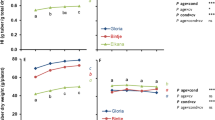Abstract
In vitro potato plantlets of cultivar (cv.) Shepody (Solatium tuberosum L.) were exposed to 12-or 16-hr photoperiods for 8 weeks. Plantlets were acclimatized to the greenhouse and grown under 14-hr photoperiods until they senesced, and minitubers were harvested. Greenhouse-grown potato plants developed from tissue-culture plantlets exposed to a 16-hr photoperiod were taller and had more nodes than plants developed from plantlets exposed to 12-hr photoperiods. However, yield data of minitubers from greenhousegrown plants indicated that the 12-hr photoperiodic treatment increased the numbers, dry weight and specific gravity of minitubers. A further advantage of the 12-hr photoperiodic treatment was the greater numbers of minitubers in the 15–40 g size class compared with tubers in the <15 g and >40 g size classes. Thus, for the cv. Shepody, plant height and node number of greenhouse-grown plants were not good indicators of minituber yield from that crop. Seed potato nuclear stock facilities producing minitubers should investigate the possibility of optimizing minituber production by exposing multiplication cultures to shorter daylengths.
Compendio
Plantitas in vitro de papa del cultivar (cv.) Shepody (Solatium tuberosum L.) fueron expuestas a fotoperiodos de 12 o 16 hr, por ocho (8) semanas. Las Plantitas fueron aclimatadas al invernadero y crecieron bajo fotoperiodos de 14 hr hasta su senescencia, cosechándose sus tuberculillos. Las plantas que crecieron en el invernadero, desarrolladas de plantitas procedentes de cultivos de tejidos expuestos a fotoperiodos de 16 hr, fueron mas altas y tuvieron más nudos que las plantas desarrolladas de plantitas expuestas a fotoperiodos de 12 hr. Sin embargo, la información sobre el rendimiento en tuberculillos de las plantas que crecieron en el invernadero indicó que el tratamiento fotoperiódo de 12 hr incrementó el número, el peso seco y la gravedad específica de los tuberculillos. Una ventaja adicional del tratamiento fotoperiódico de 12 hr fue el mayor número de tuberculillos en la clase del tamaño de 15–40 g, en comparación con los tubérculos en la clase de los tamanos <15 y >40 g. Por lo tanto, para el cv. Shepody, la altura de planta y el número de nudos de las plantas mantenidas en invernadero no fueron buenos indicadores del rendimiento en tuberculillos de ese cultivo. Las instalaciones de existencias nucleares de semilla de papa produciendo tuberculillos deben investigar la posibilidad de optimizar la producción de tuberculillos exponiendo los cultivos de multiplicación a longitudes de día más cortas.
Similar content being viewed by others
Literature Cited
Bryan, J.E., M.T. Jackson, M. Quevedo and N. Melendez B. 1981. Single-node cuttings, a rapid multiplication technique for potatoes. Series I: Rapid Multiplication Techniques for Potatoes. Guide-Book 1/2 Int. Potato Center, Lima, Peru:l-8.
Chailakhyan, M. Kh L.I. Yanina, A.G. Devedzhyan and G.N. Lotova. 1982. Photoperiodic control of tuber formation in grafting of tobacco on potato. Dokl Akad Nauk SSSR 265 (5): 1276–1280.
Coombs, D.T. 1992. The contribution of minitubers to the health of commercial potato seed. Aspects Appl Biol 33:63–70.
Ewing, E.E. 1990. Induction of tuberization in potato. Chap. 3In: The Molecular and Cellular Biology of the Potato. [Eds. M.E. Vayda and W.D. Park]. No. 3, C.A.B. Int, Oxford, UK:25–41.
Garner, N. and J. Blake. 1989. The induction and development of potato microtubersin vitro on media free of growth regulating substances. Ann Bot 63:663–674.
Jones, E.D. 1988. A current assessment onin vitro culture and other rapid multiplication methods in North America and Europe. Am Potato J 65:209–220.
Jones, E.D. 1991. Progress in seed production technology. Am Potato J 68:247–248.
Kubota, C. and T. Kozai. 1992. Growth and net photosynthetic rate ofSolanum tuberosum in vitro under forced and natural ventilation. HortScience 27:1312–1314.
Lentini, Z. and E.D. Earle. 1991.In vitro tuberization of potato clones from different maturity groups. Plant Cell Rep 9:691–695.
McCowan, B.H. and I. Kass. 1977. Effect of production temperature of seed potatoes on subsequent yielding potential. Am Potato J 54:277–287.
Melching, J.B., A. Slack and E.D. Jones. 1993. Field performance of peat-lite mix encapsulated small minitubers. Am Potato J 70:285–299.
Mendoza, H.A. and F.L. Haynes. 1977. Inheritance of tuber initiation in tuber bearingSolanum as influenced by photoperiod. Am Potato J 54:243–252.
Murashige, T. and F. Skoog. 1962. A revised medium for rapid growth and bioassays with tobacco tissue cultures. Physiol Plant 15:473–497.
Pelacho, A.M. and A.M. Mingo Castel. 1991. Effects of photoperiod on kinetin-induced tuberization of isolated potato stolons culturedin vitro. Am Potato J 68:533–541.
Seabrook, J.E.A., S. Coleman and D. Levy. 1993. Effect of photoperiod onin vitro tuberization of potato (Solanum tuberosum L.). Plant Cell Tissue Organ Cult 34:43–51.
Sokal, R.R. and F.J. Rohlf. 1981. Biometry. 2nd Edit. W.H. Freeman & Co., New York. 859 pp.
Struik, P.C. and W.J.M. Lommen. 1990. Production, storage and use of microand minitubers. Conf Proc 11 Triennial Conf EAPR, 8–13 July 1990, Edinburgh, UK:122-133.
Struik, P.C., E. van Heusden and K. Burger Meyer. 1988. Effects of short periods of long days on the development, yield, and size distribution of potato tubers. Neth J Agric Sci 36:11–22.
Struik, P.C., D. Vreugdenhil, AJ. Haverkort, C.B. Bus and R. Dankert. 1991. Possible mechanisms of size hierarchy among tubers on one stem of a potato (Solanum tuberosum L.) plant. Potato Res 34:187–203.
Went, F.W. 1959. Effects of environment of parent and grandparent generations on tuber production by potatoes. Am J Bot 46:277–282.
Wurr, D.C.E., J.R. Fellows, J.R. Lynn and EJ. Allen. 1993. The impact of some agronomic factors on the variability of potato tuber size distribution. Potato Res 36:237–245.
Author information
Authors and Affiliations
Rights and permissions
About this article
Cite this article
Seabrook, J.E.A., Percy, J.E., Douglass, L.K. et al. Photoperiodin vitro affects subsequent yield of Greenhouse-grown potato tubers. American Potato Journal 72, 365–373 (1995). https://doi.org/10.1007/BF02849333
Accepted:
Issue Date:
DOI: https://doi.org/10.1007/BF02849333




